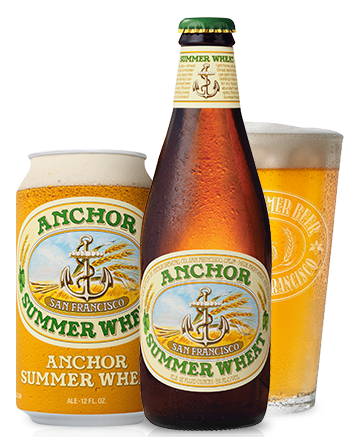Summer Beer: When Brewers Warmed to the Hottest Season
In the summer of 1984, the Anchor Brewing Co. in San Francisco released what it called Anchor Summer Wheat. It marked a watershed in beer packaging: the first widely available American-made beer to explicitly call itself “summer” in some way.
Such beers now seem ubiquitous in these warmer months, but they were quite rare in the U.S. until the mid-1990s, when a kind of great leap forward took place that saw several breweries, huge and small, scramble to slap the word somewhere on their cans or bottles.
 Also, to be clear: There had been lighter, more citrusy lagers and ales regularly on the market before Anchor Summer Wheat—the exact kinds of beers that are supposed to appeal to consumers when the mercury starts pushing upward in the Northern Hemisphere. And there had been advertisements stretching back to at least the 1940s touting the benefits of a cold one during hot summer activities such as camping, boating and going to the ballpark.
Also, to be clear: There had been lighter, more citrusy lagers and ales regularly on the market before Anchor Summer Wheat—the exact kinds of beers that are supposed to appeal to consumers when the mercury starts pushing upward in the Northern Hemisphere. And there had been advertisements stretching back to at least the 1940s touting the benefits of a cold one during hot summer activities such as camping, boating and going to the ballpark.
Like with the word “Christmas” on richer winter offerings, however, there was that point a generation ago now when the season’s actual name started appearing in all its beach-blanket, by-the-lake glory.
As for that Anchor Summer Wheat, it was—and is—exactly what it sounds like: a lighter-tasting, lower-alcohol beer made with a grain bill of more than 50 percent malted wheat. The brewery, no stranger to pioneering moves, released the beer precisely for the summer months. If its taste, aroma and mouthfeel (and name) left any doubt, the bright, yellow label likely removed it.
For several years, the Anchor offering stood alone among “summer” beers. Then, in 1992, it appears the Sierra Nevada Brewing Co. out of Chico, California, first released Summerfest, a lager that it described on the label as a “crisp summer beer.” (The brewery is not quite certain when Summerfest first debuted; it says it has been brewing it since at least ’92.)
Three years later, Pete’s Brewing Co., the contract operation then growing into the country’s second-biggest micro-brewing operation, released Pete’s Wicked Summer Brew. That beer seems to have kicked the door open, in no small part because it rolled out to as many as 47 states, including in cans. It also became one of the first beers that an airline carried from a smaller-sized brewing company, in this case Continental beginning in the late 1990s.
These summer releases came amid a decade of frenetic growth in American beer, particularly among tinier breweries making smaller batches of beer with more traditional ingredients. As the number of entrants swelled, so did the number of new brands. These summer beers were a part of that, as the previously American lager-centric marketplace flowered in all sorts of directions.
Before the 1990s were out, numerous breweries had piled on the summer-beer RV that Anchor, Sierra and Pete’s cranked up: Boston Beer (Samuel Adams Summer Ale); D.L. Geary’s Summer Ale; Goose Island’s Summertime Kolsch; Otter Creek’s Summer Wheat Ale; Capital Brewery’s Summer Fest; Harpoon Summer Ale from the Mass. Bay Brewing Co. in Boston; and more.
Summer beer also survived the great shakeout that gripped the industry at the tail end of the 1990s, when nearly 200 breweries and brewpubs went out of business. They may have seemed kitschy or stylistically redundant—most summer beers were just wheats, kolsches, etc., by another name— but they have clearly proved particularly popular among consumers and remunerative for brewers. After all, you don’t see too many “autumn” beers out there.
Read more Acitelli on History posts.
Tom Acitelli is the author of The Audacity of Hops: The History of America’s Craft Beer Revolution. His new book, American Wine: A Coming-of-Age Story, is available for pre-order. Reach him on Twitter @tomacitelli.

I think ‘Oktoberfest’ has that autumn category all sewn up